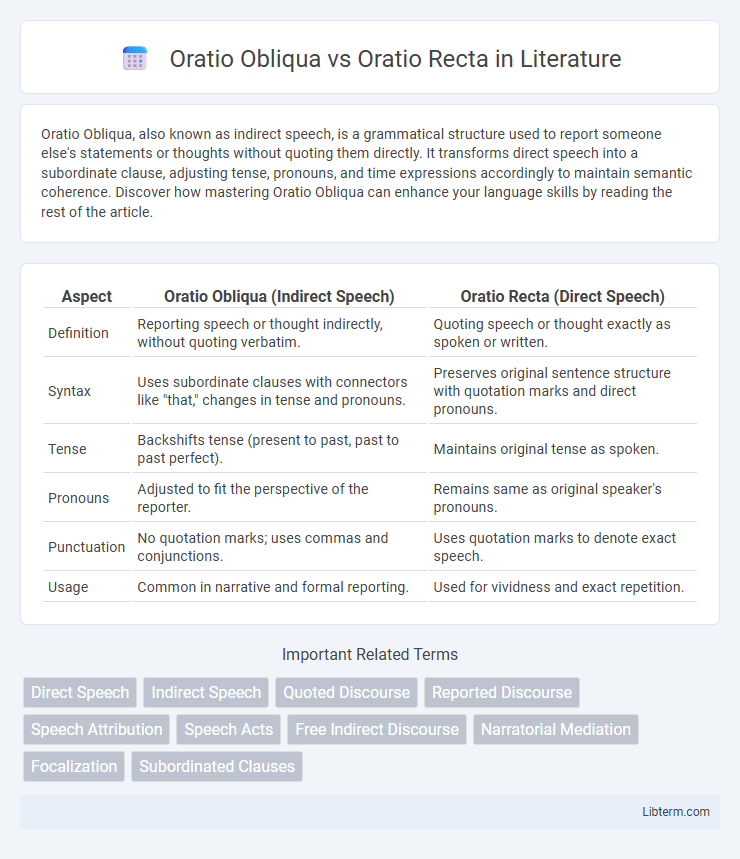Oratio Obliqua, also known as indirect speech, is a grammatical structure used to report someone else's statements or thoughts without quoting them directly. It transforms direct speech into a subordinate clause, adjusting tense, pronouns, and time expressions accordingly to maintain semantic coherence. Discover how mastering Oratio Obliqua can enhance your language skills by reading the rest of the article.
Table of Comparison
| Aspect | Oratio Obliqua (Indirect Speech) | Oratio Recta (Direct Speech) |
|---|---|---|
| Definition | Reporting speech or thought indirectly, without quoting verbatim. | Quoting speech or thought exactly as spoken or written. |
| Syntax | Uses subordinate clauses with connectors like "that," changes in tense and pronouns. | Preserves original sentence structure with quotation marks and direct pronouns. |
| Tense | Backshifts tense (present to past, past to past perfect). | Maintains original tense as spoken. |
| Pronouns | Adjusted to fit the perspective of the reporter. | Remains same as original speaker's pronouns. |
| Punctuation | No quotation marks; uses commas and conjunctions. | Uses quotation marks to denote exact speech. |
| Usage | Common in narrative and formal reporting. | Used for vividness and exact repetition. |
Introduction to Oratio Obliqua and Oratio Recta
Oratio Obliqua and Oratio Recta are two fundamental methods of reporting speech in linguistics. Oratio Recta refers to direct speech where the exact words of the speaker are quoted, often enclosed in quotation marks, preserving the original tense and perspective. In contrast, Oratio Obliqua, or indirect speech, involves paraphrasing the speaker's message, typically requiring changes in pronouns, tense, and time expressions to fit the narrative context.
Defining Oratio Obliqua (Indirect Speech)
Oratio Obliqua, or indirect speech, involves reporting someone's words without quoting them verbatim, often using a subordinate clause introduced by conjunctions like "that" or "if." This form allows the speaker to convey information, thoughts, or questions with changes in pronouns, tense, and word order to suit the reporting context. Unlike Oratio Recta, or direct speech, which presents the exact words spoken within quotation marks, Oratio Obliqua integrates the reported speech smoothly into the narrative structure.
Understanding Oratio Recta (Direct Speech)
Oratio Recta (Direct Speech) involves quoting the exact words spoken by a person, preserving the original tense, pronouns, and expressions. It is typically marked by quotation marks and can include exclamations, questions, or statements, providing a clear and precise representation of speech. Understanding Oratio Recta is essential for accurately conveying a speaker's intent and emotional nuance without altering the original message.
Key Differences Between Oratio Obliqua and Oratio Recta
Oratio Obliqua involves indirect speech where the original speaker's words are reported without quotation marks, often requiring shifts in tense, pronouns, and time expressions to fit the context. Oratio Recta features direct speech, quoting the exact words spoken, preserving the original tense, pronouns, and expressions within quotation marks. The key difference lies in the representation: Oratio Recta directly replicates the speaker's utterance, while Oratio Obliqua transforms it to align with the narrator's perspective.
Grammatical Structures in Oratio Obliqua
Oratio obliqua transforms direct speech (oratio recta) by embedding it into an indirect discourse through verb tense shifts, pronoun changes, and often altering time expressions to reflect the speaker's perspective. Key grammatical structures include the backshifting of verb tenses, such as present to past, and the use of conjunctions like "that" to introduce subordinate clauses. Mastery of mood changes, especially from indicative to subjunctive or infinitive forms, is crucial in accurately conveying the original utterance within oratio obliqua.
Grammatical Structures in Oratio Recta
Oratio Recta, or direct speech, involves quoting the exact words spoken, preserving original grammatical structures such as verb tense, pronouns, and word order. It maintains the speaker's exact expression, using present or past tense verbs as originally stated, and retains interrogative or imperative sentence forms. This contrasts with Oratio Obliqua, where these grammatical elements are often altered to fit indirect speech conventions.
Usage in Classical Languages and Literature
Oratio obliqua, or indirect speech, is commonly used in classical Latin and Greek literature to report speech, thoughts, or commands without direct quotation, often marked by subjunctive moods and changes in pronouns and verb tenses according to sequence of tenses rules. Oratio recta, or direct speech, appears as verbatim quotations in classical texts, maintaining the original speaker's exact words and intonation, typically enclosed in quotation marks in modern editions. Latin authors like Cicero and Greek tragedians such as Sophocles employ oratio obliqua to convey reported dialogue subtly, whereas oratio recta is more prominent in dialogues and dramatic speeches to preserve the rhetorical and emotional force of the original utterance.
Common Mistakes and Challenges
Common mistakes in Oratio Obliqua include incorrect verb tense shifts and misalignment of pronouns, causing confusion in reported speech. Learners often struggle with accurately converting direct quotations (Oratio Recta) into indirect speech while preserving the original meaning and context. Challenges also arise in handling time expressions and modal verbs, requiring careful attention to grammatical rules to avoid distortions.
Practical Applications in Modern Language Learning
Oratio obliqua (indirect speech) enhances comprehension of sentence structure and verb tense shifts, crucial for mastering complex conversations and narrative reports in modern language learning. Oratio recta (direct speech) develops skills in quoting and expressing thoughts verbatim, improving fluency and natural dialogue creation. Combining both techniques supports effective communication, listening comprehension, and cultural contextualization in real-world language use.
Summary and Final Thoughts
Oratio Obliqua, or indirect speech, conveys a speaker's words without quotation marks, often requiring tense shifts and pronoun changes to maintain coherence. Oratio Recta, or direct speech, replicates the speaker's exact words within quotation marks, preserving original tense and perspective. Choosing between Oratio Obliqua and Oratio Recta depends on narrative style and clarity, with indirect speech offering more fluid integration into the text and direct speech emphasizing authenticity and immediacy.
Oratio Obliqua Infographic

 libterm.com
libterm.com